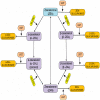Degradation of zearalenone by microorganisms and enzymes
- PMID: 37601268
- PMCID: PMC10434127
- DOI: 10.7717/peerj.15808
Degradation of zearalenone by microorganisms and enzymes
Abstract
Mycotoxins are toxic metabolites produced by fungi that may cause serious health problems in humans and animals. Zearalenone is a secondary metabolite produced by fungi of the genus Fusarium, widely exists in animal feed and human food. One concern with the use of microbial strains and their enzyme derivatives for zearalenone degradation is the potential variability in the effectiveness of the degradation process. The efficiency of degradation may depend on various factors such as the type and concentration of zearalenone, the properties of the microbial strains and enzymes, and the environmental conditions. Therefore, it is important to carefully evaluate the efficacy of these methods under different conditions and ensure their reproducibility. Another important consideration is the safety and potential side effects of using microbial strains and enzymes for zearalenone degradation. It is necessary to evaluate the potential risks associated with the use of genetically modified microorganisms or recombinant enzymes, including their potential impact on the environment and non-target organisms. Additionally, it is important to ensure that the degradation products are indeed harmless and do not pose any health risks to humans or animals. Furthermore, while the use of microbial strains and enzymes may offer an environmentally friendly and cost-effective solution for zearalenone degradation, it is important to explore other methods such as physical or chemical treatments as well. These methods may offer complementary approaches for zearalenone detoxification, and their combination with microbial or enzyme-based methods may improve overall efficacy. Overall, the research on the biodegradation of zearalenone using microorganisms and enzyme derivatives is promising, but there are important considerations that need to be addressed to ensure the safety and effectiveness of these methods. Development of recombinant enzymes improves enzymatic detoxification of zearalenone to a non-toxic product without damaging the nutritional content. This review summarizes biodegradation of zearalenone using microorganisms and enzyme derivatives to nontoxic products. Further research is needed to fully evaluate the potential of these methods for mitigating the impact of mycotoxins in food and feed.
Keywords: Degradation; Enzyme; Microorganisms; Mycotoxins; Zearalenone (ZEN).
©2023 Gari and Abdella.
Conflict of interest statement
The authors declare there are no competing interests.
Figures
Similar articles
-
Microbial and enzymatic battle with food contaminant zearalenone (ZEN).Appl Microbiol Biotechnol. 2022 Jun;106(12):4353-4365. doi: 10.1007/s00253-022-12009-7. Epub 2022 Jun 15. Appl Microbiol Biotechnol. 2022. PMID: 35705747 Review.
-
[Progress in bio-degradation of mycotoxin zearalenone].Sheng Wu Gong Cheng Xue Bao. 2018 Apr 25;34(4):489-500. doi: 10.13345/j.cjb.170337. Sheng Wu Gong Cheng Xue Bao. 2018. PMID: 29701023 Review. Chinese.
-
Microbial detoxification of mycotoxins in food and feed.Crit Rev Food Sci Nutr. 2022;62(18):4951-4969. doi: 10.1080/10408398.2021.1879730. Epub 2021 Mar 5. Crit Rev Food Sci Nutr. 2022. PMID: 33663294 Review.
-
Review on biological degradation of mycotoxins.Anim Nutr. 2016 Sep;2(3):127-133. doi: 10.1016/j.aninu.2016.07.003. Epub 2016 Jul 19. Anim Nutr. 2016. PMID: 29767078 Free PMC article. Review.
-
A critical evaluation of health risk assessment of modified mycotoxins with a special focus on zearalenone.Mycotoxin Res. 2019 Feb;35(1):27-46. doi: 10.1007/s12550-018-0328-z. Epub 2018 Sep 13. Mycotoxin Res. 2019. PMID: 30209771 Free PMC article.
Cited by
-
Unlocking the Potential of Bacillus subtilis: A Comprehensive Study on Mycotoxin Decontamination, Mechanistic Insights, and Efficacy Assessment in a Liquid Food Model.Foods. 2025 Jan 22;14(3):360. doi: 10.3390/foods14030360. Foods. 2025. PMID: 39941953 Free PMC article.
-
Study on the Modification of Dietary Fiber and Degradation of Zearalenone in Corn Germ Meal by Solid-State Fermentation with Bacillus subtilis K6.Foods. 2025 Jul 30;14(15):2680. doi: 10.3390/foods14152680. Foods. 2025. PMID: 40807619 Free PMC article.
-
Efficacy of a multicomponent binding agent against combined exposure to zearalenone and ochratoxin A in weaned pigs.Front Vet Sci. 2024 Mar 6;11:1357723. doi: 10.3389/fvets.2024.1357723. eCollection 2024. Front Vet Sci. 2024. PMID: 38511191 Free PMC article.
-
A Novel Bacillus Velezensis for Efficient Degradation of Zearalenone.Foods. 2024 Feb 9;13(4):530. doi: 10.3390/foods13040530. Foods. 2024. PMID: 38397507 Free PMC article.
-
Characteristics of a Novel Zearalenone Lactone Hydrolase ZHRnZ and Its Thermostability Modification.Int J Mol Sci. 2024 Sep 6;25(17):9665. doi: 10.3390/ijms25179665. Int J Mol Sci. 2024. PMID: 39273612 Free PMC article.
References
-
- Arroyo-Manzanares N, Campillo N, López-García I, Hernández-Córdoba M, Viñas P. High-resolution mass spectrometry for the determination of mycotoxins in biological samples. A review. Microchemical Journal. 2021;166:106197. doi: 10.1016/j.microc.2021.106197. - DOI
Publication types
MeSH terms
Substances
LinkOut - more resources
Full Text Sources


